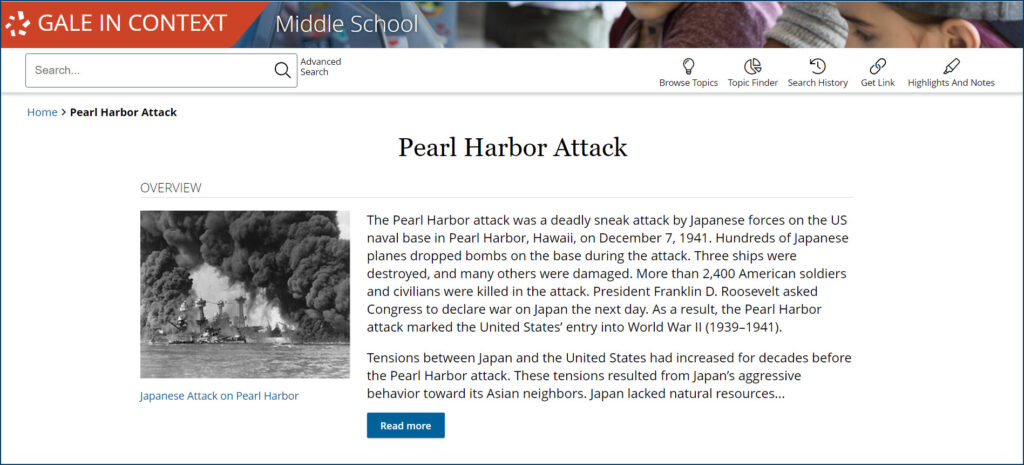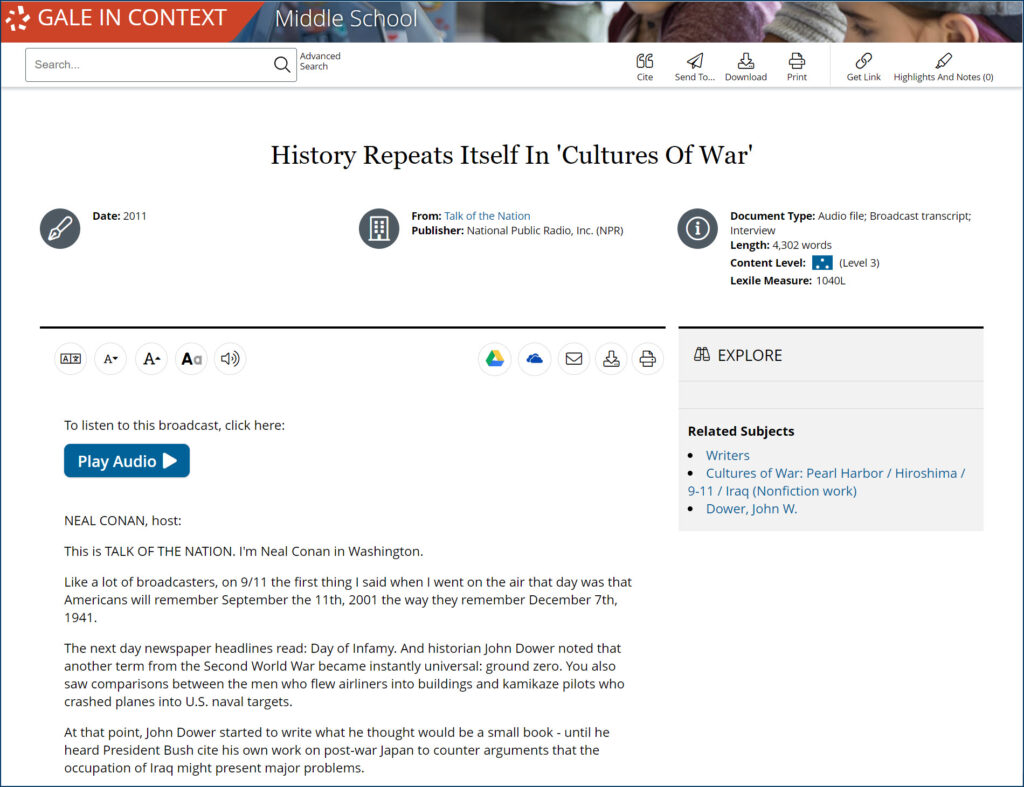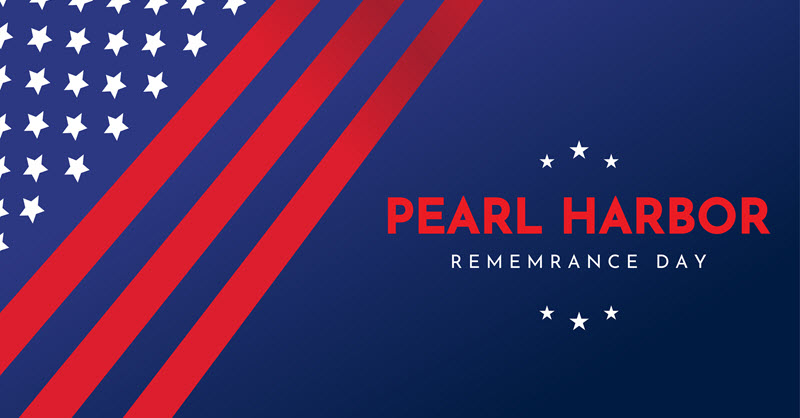| By Gale Staff |
On December 7, 1941, there was an attack on the Pearl Harbor U.S. military base. Despite World War II’s looming presence, the United States was not actively involved in the war and, thus, was unprepared for an enemy military offensive. Over 2,000 Americans were killed, and the assault remains the deadliest attack on American soil in the twentieth century. In 1994, Congress formally designated December 7th as National Pearl Harbor Remembrance Day to honor those who died in the attack. Each year, the Pearl Harbor National Memorial in Honolulu, Hawaii, observes a special commemoration ceremony for that sacrifice.
Compared to the September 11 attacks which are so near in history’s rearview mirror, your middle schoolers might not comprehend the cultural shock and magnitude of Pearl Harbor. But to Americans in the early 20th century, such an assault on U.S. soil was inconceivable. This December, use Gale In Context: Middle School to discover more about Pearl Harbor’s compelling story and the experiences of those who witnessed the attack. Whether a standalone lesson for the anniversary or a highlight within your larger World War II unit, Pearl Harbor is a gripping tale with intriguing parallels to modern-day tensions.
Gale In Context: Middle School is your one-stop research database for 6th through 12th grade students. Sophisticated enough for their growing curiosity, Middle School nonetheless echoes the easy navigation and visual aids of our elementary resources, serving as a bridge to more advanced learning. Plus, information is available through a range of media, from traditional news articles to podcasts, making Pearl Harbor research more accessible for all learning styles.
This December, educate students on the attack at Pearl Harbor through Gale In Context: Middle School’s dedicated topic page. This special, curriculum-aligned resource features thousands of pieces of diverse content, all vetted by Gale’s expert team.

Create Historical Context
The Pearl Harbor attack was a dramatic entry into learning about World War II, but the theater really started years earlier. How exactly did the United States find itself the victim of a surprise attack? To get started, dive into Gale In Context: Middle School‘s Pearl Harbor attack summary page and introduce the historical and political context underlining the assault.
The conflict between the Japanese military and the United States started earlier than 1941. Much of the spark has roots in the early 1930s. As an economically expanding island nation, Japan relied heavily on other countries for its natural resources. As a result, Japan sought additional territory to access these necessary assets. Their expansion contributed to the Sino-Japanese War in 1937. In response, the United States levied economic penalties against the island nation to the east. Unfortunately, this move pushed the Japanese to seek support elsewhere, notably Adolf Hitler’s growing influence in Europe.
Activity Idea: Build a timeline starting with the Manchurian Incident through the atomic bombing of Hiroshima and Nagasaki. Pay special attention to the placement of the Pearl Harbor attack and its context within the overall global conflict. With this snapshot of the full picture, ask your students whether U.S. involvement in World War II was inevitable or a direct result of the Pearl Harbor attack.
Hear the Voices of the Time
Some of the most valuable resources in the Gale In Context: Middle School Pearl Harbor content are its primary sources. Primary sources, such as letters, interviews, speeches, and photographs, help students relate to historical events in a more personal way. Resources directly linked to the time period provide a uniquely authentic perspective and inspire a richer understanding of how it felt to experience the conflict. Read the transcript of President Franklin D. Roosevelt’s Fireside Chat on the Declaration of War with Japan. Held just two days after the attack on Pearl Harbor, Roosevelt addressed the American people over the radio. The United States was officially entering the war.
Of course, there are two sides to any conflict. In a fear-based decision, the U.S. government forced over 100,000 people of Japanese descent into internment camps. What was considered a reasonable decision at the time is now viewed as a massive civil rights violation of American citizens. Later, in 1945, over 100,000 Japanese people were killed in the bombings of Hiroshima and Nagasaki. New Yorker reporter, John Hersey, traveled to the bombing sites and interviewed survivors. His work helped inspire empathy worldwide for those caught up in the violence of war.
Discussion Idea: Introduce the concepts of nationalism and propaganda. With Gale In Context: Middle School, you can find visual examples of propaganda used during World War II. How do these political tools affect our perspectives of others as the “enemy?” How did John Hersey’s article add nuance and humanity to the war?
Explore the Parallels of History
With Gale In Context: Middle School‘s Pearl Harbor content, your students can learn about a momentous time in American history. Aside from the attack itself, they’ll explore the global tensions leading up to the event and the consequences of a modern-day attack on U.S. soil. As the old truism says—history repeats itself. They’ll undoubtedly make critical connections between the story and fallout of Pearl Harbor and today’s social and political issues.

The United States has a long history of anti-Asian violence, pre-dating the attack on Pearl Harbor. A century later, the country continues to grapple with anti-Asian hate crimes, especially in the wake of the COVID-19 pandemic. There are other parallels to make as well. Pearl Harbor set a precedent by which an attack on U.S. soil would launch the American military onto the international stage. While the strategic outcomes differed, many scholars drew powerful connections to the events of September 11, 2001.
Discussion Idea: As students learn more about the attack on Pearl Harbor, encourage them to share similarities between the 1941 event and modern-day conflicts. How are they different? These compelling questions help your students foster their critical-thinking skills in regard to history, war, and modern-day xenophobia.
The attack on Pearl Harbor, the political nuances of World War II, and the bombing of Hiroshima are complicated, multidimensional topics that require time and attention. However, teachers already have so many responsibilities to juggle, so it may feel daunting to integrate such heavy themes into your December lesson planning. For this reason, the team at Gale has developed a teacher-specific database to help you save time and stay organized. Gale In Context: For Educators features ready-made lesson plans and engaging classroom activities for year-round themes and all ages. Plus, this resource features collaboration and customization tools to help you network with colleagues and personalize your curriculum.
With Gale in Context: Middle School and Gale In Context: For Educators, you can confidently guide students through the events that occurred on December 7, 1941. At the same time, you can help them see critical historical parallels and the lingering consequences of that attack. Help inspire respect and empathy for those who lost their lives and loved ones to war, regardless of nationality or beliefs.
If your institution isn’t a current Gale subscriber, learn more by visiting our website.

